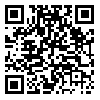Volume 6, Issue 4 (2021)
IJMPP 2021, 6(4): 573-579 |
Back to browse issues page
Download citation:
BibTeX | RIS | EndNote | Medlars | ProCite | Reference Manager | RefWorks
Send citation to:



BibTeX | RIS | EndNote | Medlars | ProCite | Reference Manager | RefWorks
Send citation to:
Pirjade A. Effectiveness of Hip Muscle Strengthening and Backward walking in Pirformis Syndrome. IJMPP 2021; 6 (4) :573-579
URL: http://ijmpp.modares.ac.ir/article-32-54365-en.html
URL: http://ijmpp.modares.ac.ir/article-32-54365-en.html
Faculty of Physiotherapy, Krishna Institute of Medical Sciences; Deemed to be university; Karad , Maharashtra, India. , ambarin66@gmail.com
Abstract: (1299 Views)
Aim: Piriformis syndrome is a group of symptoms and signs of pain from the piriformis muscle and is considered by pain in the buttock with variable involvement of the sciatic nerve. The aids of neural mobilization and piriformis stretching are commonly described and are known, but the effects and role of hip abductor and extensor strengthening along with backward walking is not well ss the edescribed. This study aimed to assess the effectiveness of hip muscle strengthening and backward walking in pirformis syndrome as a pilot study.
Method and Materials: In total, 76 subjects with piriformis syndrome were randomly assigned into two groups (Group A and Group B). Subjects in group A (n=38) received hip abductor and extensor strengthening and backward walking along with neural mobilization and piriformis stretching whereas, group B (n=38) received only neural mobilization and piriformis stretching for four weeks. Pain intensity was measured by Numerical Pain Rating Scale (NPRS) and lumbar range of motion was measured using Universal Goniometer.
Results: This study showed a statistically significant improvement in both the groups for pain intensity. However, the pain severity was considerably reduced more in group A. Furthermore lumbar ROM improvement was seen significantly more in Group A.
Conclusion: The study demonstrated that hip abductor and extensor strengthening along with backward walking have an added efficacy in improving lumbar flexibility and decreasing pain when combined with neural mobilization and piriformis stretching exercises.
Method and Materials: In total, 76 subjects with piriformis syndrome were randomly assigned into two groups (Group A and Group B). Subjects in group A (n=38) received hip abductor and extensor strengthening and backward walking along with neural mobilization and piriformis stretching whereas, group B (n=38) received only neural mobilization and piriformis stretching for four weeks. Pain intensity was measured by Numerical Pain Rating Scale (NPRS) and lumbar range of motion was measured using Universal Goniometer.
Results: This study showed a statistically significant improvement in both the groups for pain intensity. However, the pain severity was considerably reduced more in group A. Furthermore lumbar ROM improvement was seen significantly more in Group A.
Conclusion: The study demonstrated that hip abductor and extensor strengthening along with backward walking have an added efficacy in improving lumbar flexibility and decreasing pain when combined with neural mobilization and piriformis stretching exercises.
Article Type: Original Research |
Subject:
Musculoskeletal Pain Prevention
Received: 2021/07/26 | Accepted: 2021/10/2 | Published: 2021/10/9
Received: 2021/07/26 | Accepted: 2021/10/2 | Published: 2021/10/9
References
1. Kirschner JS, Foye PM, Cole JL. Piriformis syndrome, diagnosis and treatment. Muscle Nerve. 2009;40(1):10-8. [DOI:10.1002/mus.21318]
2. Cramp F, Bottrell O, Campbell H, Ellyatt P, Smith C, Wilde B. Non-surgical management of piriformis syndrome: a systematic review. Phys. Ther. Rev. 2007;12(1):66-72. [DOI:10.1179/108331907X175014]
3. Boyajian-O'Neill LA, McClain RL, Coleman MK, Thomas PP. Diagnosis and management of piriformis syndrome: an osteopathic approach. J Am Osteopath Assoc. 2008;108(11):657-64. [DOI:10.7556/jaoa.2008.108.11.657]
4. Laha K, Sarkar B, Kumar P, Patel L, Sarkar N. Efficacy of hip abductor and extensor strengthening on pain, strength and lower extremity function in piriformis syndrome: a randomized clinical trial. Int J Health Sci Res. 2018;8(9):80-8.
5. Siddiq MAB. Piriformis syndrome and wallet neuritis: are they the same? Cureus. 2018;10(5). [DOI:10.7759/cureus.2606]
6. Yeoman W. The relation of arthritis of the sacroiliac joint to sciatica, with an analysis of 100 cases. The Lancet. 1928;212(5492):1119-23. [DOI:10.1016/S0140-6736(00)84887-4]
7. Robinson DR. Pyriformis syndrome in relation to sciatic pain. Am. J. Surg. 1947;73(3):355-8. [DOI:10.1016/0002-9610(47)90345-0]
8. Akdemir Ozisik P, Toru M, Denk CC, Taskiran OO, Gundogmus B. CT-guided piriformis muscle injection for the treatment of piriformis syndrome. Turk Neurosurg. 2014;24(4):471-7. [DOI:10.5137/1019-5149.JTN.8038-13.1]
9. Chen W. Sciatica due to piriformis pyomyositis. Report of a case. J Bone Joint Surg Am. 1992;74(10):1546-8. [DOI:10.2106/00004623-199274100-00015]
10. Hallin RP. Sciatic pain and the piriformis muscle. Postgrad Med. 1983;74(2):69-72. [DOI:10.1080/00325481.1983.11698378]
11. Chapman C, Bakkum BW. Chiropractic management of a US Army veteran with low back pain and piriformis syndrome complicated by an anatomical anomaly of the piriformis muscle: a case study. J. Chiropr. Med. 2012;11(1):24-9. [DOI:10.1016/j.jcm.2011.06.011]
12. Hopayian K, Song F, Riera R, Sambandan S. The clinical features of the piriformis syndrome: a systematic review. Eur. Spine J. 2010;19(12):2095-109. [DOI:10.1007/s00586-010-1504-9]
13. Remvig L, Ellis RM, Patijn J. Piriformis Syndrome - Definitions, Reproducibility and Validity of Diagnostic Procedures and Results of Efficacy Trials, J. Orthop. Surg. Res.2004; 26 (2): 67-76. [DOI:10.1080/1355297X.2004.11736230]
14. Magora A. Investigation of the relation between low back pain and occupation: IV. Physical requirements: Bending, rotation, reaching, and sudden maximal effort. Scand J Rehabil Med. 1973;5:186-90.
15. Shacklock MO. Clinical Neurodynamics: A New System of Musculoskeletal Treatment. Edinburgh, UK: Elsevier Health Sciences; First edition 2005
16. Pradip B, Sudhir B and Nidhi B .Prevalence of tightness in hip muscles in middle aged Indian men engaging in prolonged desk jobs: A descriptive study. Int. J. Phys. Educ. Sports Health 2018; 5(2): 15-21.
Send email to the article author
| Rights and permissions | |
 |
This work is licensed under a Creative Commons Attribution-NonCommercial 4.0 International License. |









